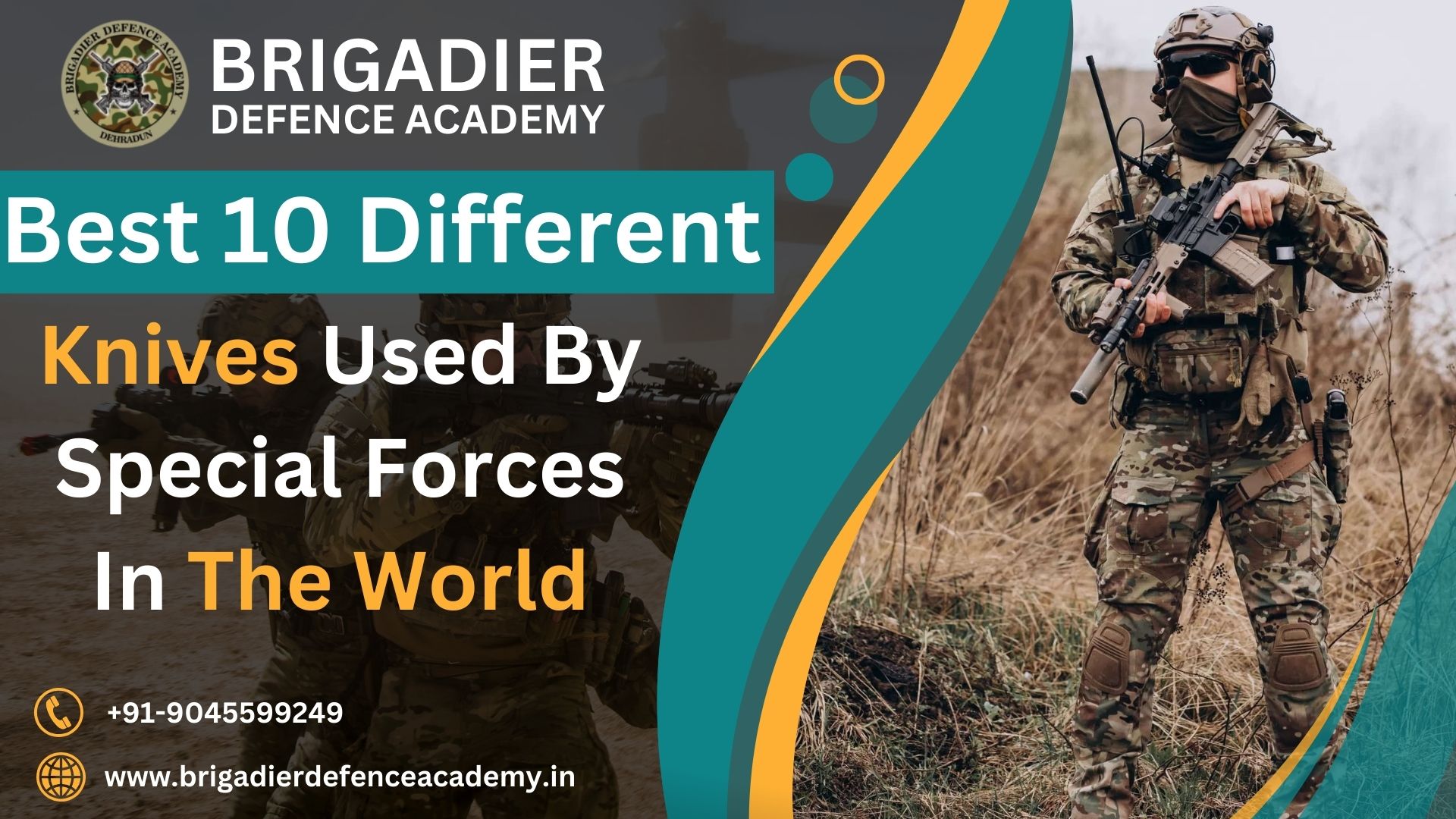- Posted on
- Manya
- No Comments
Introduction Of Different Knives Used By Special Forces In The World :
Special Forces units around the world are known for their precision, versatility, and efficiency in carrying out high-risk operations. One essential tool in their arsenal is the knife. Good knives can mean the difference between success and failure in critical missions. From stealthy covert operations to survival scenarios in harsh environments, special forces rely on a variety of knives tailored to their specific needs. In this article, we will explore 10 different knives used by special forces units from various countries, each with its unique features and purposes.
-
Ka-Bar Knives (United States):
- The Ka-Bar knife is an iconic blade used by the United States Marine Corps and other special forces units.
- It features a 7-inch straight-edge blade made of high-carbon steel, renowned for its durability and sharpness.
- The leather handle provides a secure grip even in wet conditions, making it ideal for combat and survival situations.
- Its versatility makes it suitable for a wide range of tasks, including cutting, prying, and even digging.
-
Fairbairn-Sykes Commando Knife (United Kingdom):
- Developed during World War II, the Fairbairn-Sykes Commando Knife is a classic dagger used by British special forces.
- It has a double-edged blade approximately 7 inches long, designed for swift and silent stabbing.
- The symmetrical design allows for effective thrusting and slashing motions, making it lethal in close-quarters combat.
- Its minimalist and ergonomic design facilitates easy concealment and quick deployment, making it ideal for covert operations.
-
AKM Bayonet (Russia):
- The AKM Bayonet serves as both a bayonet for the AK series rifles and a combat knife for Russian special forces.
- It features a robust blade with a distinctive clip point and sawback edge for added utility.
- The blade can be used for cutting, stabbing, and sawing through various materials, enhancing the versatility of the soldier in the field.
- Its attachment to the rifle ensures that the knife is always within reach, ready to be deployed at a moment’s notice.
-
Ontario Mark 3 Navy Knife (Canada):
- The Ontario Mark 3 Navy Knife is a rugged utility knife widely used by Canadian special forces and maritime units.
- It features a 6-inch stainless steel blade with a serrated edge near the handle, suitable for cutting through ropes and other materials.
- The synthetic handle provides a comfortable and secure grip, even in wet conditions prevalent in maritime environments.
- Its durability and corrosion resistance make it well-suited for operations in saltwater environments, such as naval boarding and maritime interdiction missions.
-
Gurkha Kukri (India):
- The Gurkha Kukri is a traditional Nepalese knife that has been adopted by Indian special forces, including the Gurkha regiments.
- It features a distinctive curved blade with a forward-sloping edge, optimized for chopping and slashing motions.
- The kukri’s design allows for powerful strikes while maintaining balance and control, making it effective in both combat and utility tasks.
- It is often carried by soldiers as a symbol of honor and heritage, reflecting the proud tradition of the Gurkha warriors who have served in the Indian military for centuries.
-
Navy SEALs Combat Knife (Israel):
- The Navy SEALs Combat Knife is a product of Israeli craftsmanship, tailored to the rigorous demands of special operations.
- It boasts a 6-inch blade made of high-quality stainless steel, chosen for its strength and edge retention properties.
- The textured polymer handle ensures a firm grip even in wet or gloved hands, providing confidence in high-stakes situations.
- Its compact and lightweight design makes it ideal for maritime operations, where space and weight are critical considerations.
-
SOG Seal Pup Elite (United States):
- The SOG Seal Pup Elite is a compact and versatile knife favored by various special forces units, including the U.S. Navy SEALs.
- It features a 4.85-inch stainless steel blade with a tanto-style point, optimized for piercing and penetration.
- The partially serrated edge near the handle enhances its cutting ability, while the spine of the blade is serrated for added utility.
- Its lightweight yet durable construction makes it suitable for a wide range of tasks, from combat and survival to everyday utility.
-
Kampfmesser 2000 (Germany):
- The Kampfmesser 2000, or KM2000, is the standard issue combat knife for German special forces, including the Kommando Spezialkräfte (KSK).
- It features a 6.7-inch blade made of high-grade stainless steel, designed for exceptional durability and corrosion resistance.
- The synthetic handle is ergonomically shaped for a comfortable and secure grip, even during prolonged use.
- Its versatile design incorporates a spear point for stabbing, a curved edge for slicing, and a serrated section for cutting through tough materials.
-
Strider SMF (United States):
- The Strider SMF is a rugged folding knife highly regarded by U.S. special forces operators for its durability and versatility.
- It features a 4-inch CPM S30V steel blade, known for its excellent edge retention and corrosion resistance properties.
- The frame lock mechanism ensures secure blade deployment and prevents accidental closure during use.
- Its compact size and folding design make it suitable for everyday carry, providing a reliable cutting tool in both urban and wilderness environments.
-
Jungle Survival Machete (Brazil):
- While not strictly a knife, the Jungle Survival Machete is an indispensable tool for Brazilian special forces operating in dense rainforest environments.
- It features a long, broad blade with a forward-curving edge, optimized for chopping through thick vegetation and performing survival tasks.
- The full tang construction and robust blade ensure durability and reliability in challenging conditions, making it an essential companion for jungle operations.
- Its versatility extends beyond combat, serving as a multipurpose tool for shelter construction, food preparation, and obstacle clearance in the wilderness.
Conclusion:
Special forces units worldwide rely on a diverse array of knives tailored to their specific operational needs. Whether it’s the rugged durability of the Ka-Bar knife favored by U.S. Marines or the traditional craftsmanship of the Gurkha Kukri carried by Indian special forces, each blade has a role to play in the success of critical missions. From close-quarters combat to survival scenarios in extreme environments, these knives are essential tools of the trade for the world’s most elite warriors.
FAQ’s
- What are special forces?
- Special forces are elite military units trained to conduct unconventional warfare, counter-terrorism operations, reconnaissance, and other high-risk missions beyond the capabilities of conventional military forces. They undergo rigorous training and selection processes to ensure they are highly skilled and adaptable in diverse operational environments.
- Why do special forces use knives?
- Knives are essential tools for special forces due to their versatility, portability, and effectiveness in various tasks. They can be used for close-quarters combat, utility tasks such as cutting, prying, and digging, as well as survival situations where access to food, shelter, and resources may be limited.
- What makes a good special forces knife?
- A good special forces knife should be durable, reliable, and versatile. It should have a strong and sharp blade capable of withstanding rigorous use in challenging environments. The handle should provide a secure grip, even in wet or gloved hands, and the overall design should be optimized for the specific needs of the user, whether it be combat, survival, or utility tasks.
- Are there specific knives used by special forces from different countries?
- Yes, special forces units from different countries often have their own preferred knives tailored to their operational requirements and preferences. These knives may vary in terms of design, materials, and intended use, reflecting the unique needs and traditions of each military organization.
- What are some common features of special forces knives?
- Common features of special forces knives include high-quality materials such as stainless steel or high-carbon steel for the blade, ergonomic handles for a secure grip, and versatile designs that incorporate features such as serrated edges, tanto points, or sawback spines for added utility. Many special forces knives also prioritize durability, corrosion resistance, and ease of maintenance to ensure reliability in demanding environments.
- Can civilians purchase special forces knives?
- Some special forces knives are available for civilian purchase, although certain models or variations may be restricted for military or law enforcement use only. It’s important for civilians to research local regulations and restrictions regarding the purchase and ownership of knives, especially those designed for military or tactical use.
- What are some famous special forces knives in popular culture?
- Special forces knives have been featured in various movies, television shows, and video games, often becoming iconic symbols of elite military units. Examples include the Fairbairn-Sykes Commando Knife from World War II, prominently featured in films like “The Dirty Dozen” and “Where Eagles Dare,” as well as modern designs like the Navy SEALs Combat Knife, depicted in video games such as the “Call of Duty” series.
- How do special forces knives differ from ordinary knives?
- Special forces knives are specifically designed and built to meet the rigorous demands of military operations, whereas ordinary knives are typically intended for general-purpose use or specific tasks such as cooking or outdoor activities. Special forces knives often feature robust construction, specialized designs, and enhanced features tailored to the unique requirements of combat, survival, and utility in hostile environments.
- Are there any cultural or historical influences on special forces knives?
- Yes, many special forces knives have cultural or historical significance, reflecting the traditions, heritage, and martial ethos of the military units that use them. For example, the Gurkha Kukri carried by Indian special forces has its roots in Nepalese culture and has been used by Gurkha warriors for centuries, while the Fairbairn-Sykes Commando Knife has a storied history dating back to World War II and the British Commandos.
- How do special forces maintain and care for their knives?
- Special forces personnel are trained in the proper maintenance and care of their equipment, including knives. This may involve regular cleaning, lubrication, and sharpening to ensure optimal performance and longevity. Additionally, special attention is often given to storing knives properly to prevent damage or corrosion while not in use, especially in harsh or corrosive environments encountered during military operations.







